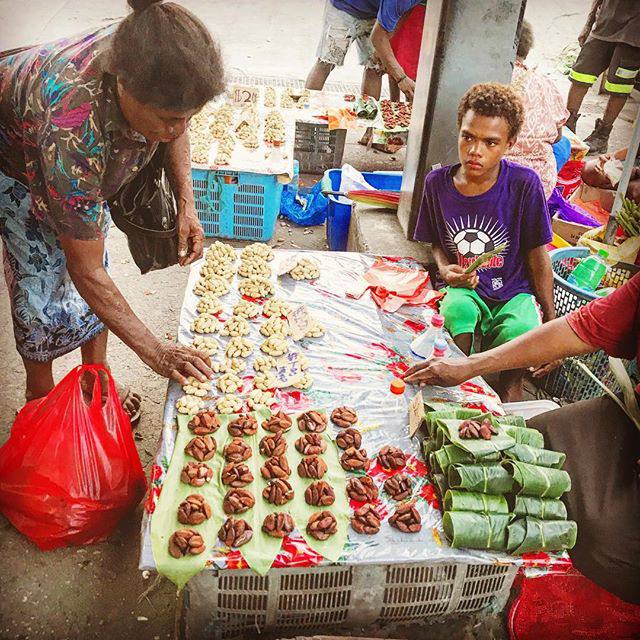When it comes to Solomon Islands cuisine, you’ll find a delicious blend of traditional Pacific Island flavors, mixed with unique local twists. There are many similarities with the foods of Papua New Guinea (PNG) and Bougainville, especially when it comes to staples like taro, sweet potatoes, and cassava. Root vegetables reign supreme in the Solomon Islands, often boiled, roasted, or mashed and served with a variety of meats and fish.
One of the defining features of Solomon Islands food is its reliance on what’s available from the surrounding seas and forests. Fish—caught fresh from the crystal-clear waters surrounding the islands—is a mainstay of the diet, often served grilled, smoked, or cooked in rich coconut milk. The influence of Bougainville is also apparent, particularly when it comes to the use of coconut in both cooking and as a refreshing drink.
The PNG and Bougainville Connection
Just as in PNG and Bougainville, mumu-style cooking (using an earth oven to slow-cook meat and vegetables) is part of Solomon Islands cuisine, though it might not be as widespread. Pigs, chicken, and even shellfish are sometimes prepared this way, depending on the community. The shared Melanesian heritage of these regions means there’s a common love for preparing large feasts for special occasions, where food is served not just for nourishment but to celebrate community ties.
Similarly, bougna, a dish in which food is wrapped in banana leaves and cooked over hot stones, resembles the mumu technique of PNG. The Solomons have a similar practice where fish or meat, combined with root vegetables, is wrapped in leaves and slow-cooked for hours.
To read about my PNG tours click here.



Coconut as the Hero Ingredient in the food of the Solomons
Coconut is king in the Solomons, just as it is in Bougainville and PNG. You’ll see it everywhere—from shredded coconut in sweet desserts to coconut cream in savory dishes. Dishes like poi, a mashed taro pudding, are enhanced with coconut milk, which adds a creamy richness to the sometimes dry starches. Fish is often cooked in a coconut milk broth, reminiscent of PNG’s coconut-based stews like kokoda.
In addition to these staples, Solomon Islanders also have a deep connection to their environment, with seafood and local game forming a significant part of their diet. Crayfish, sea cucumber, and tuna are commonly found in Solomon Island markets and kitchens, cooked in simple yet flavorful ways.
Click the link to learn about PNG cuisine.
Different Styles of Cooking in Solomon Islands cuisine
While food in the Solomon Islands may share similarities with PNG and Bougainville, it’s also influenced by the tropical environment and the diverse ethnic groups that populate the islands. In more remote areas, cooking remains highly traditional, with clay pots and earth ovens still being used. In contrast, urban areas see a slight modern twist, but even in the capital, Honiara, you’ll find fresh-caught fish grilled over an open flame on the street.





When traveling around the islands, you’ll encounter a mix of island-specific dishes, such as cassava pudding, and popular staples like sago or rice, served alongside fresh seafood and taro. Some regions are known for using wild boar or exotic game, while others favor simpler meals of steamed root vegetables and fish.
Solomon Islands Cuisine – Sweets and Desserts
Solomon Island desserts are modest but delicious. Fried bananas or coconut sweets are local favorites, particularly during festivals and community gatherings. In some areas, you’ll also find papaya, mango, and pineapple, which are commonly eaten fresh or used in light desserts.
The Solomon Islands is a place where food reflects a connection to the land and sea, much like its neighbors PNG and Bougainville. Whether you’re indulging in a fresh fish stew or enjoying a community mumu feast, you’ll see that food here is more than sustenance—it’s about bringing people together and celebrating shared heritage.
Conclusion: A Cultural Connection
While each region may have its own take on ingredients, the similarities between the Solomon Islands, PNG, and Bougainville are clear. Whether through the use of coconut, root vegetables, or communal cooking methods like the mumu, the cuisine in this part of Melanesia is all about tradition, family, and the abundance of the land and sea. If you’re a fan of simple but flavorful food, a journey through Solomon Islands cuisine will give you a taste of the Pacific in its most authentic form.

